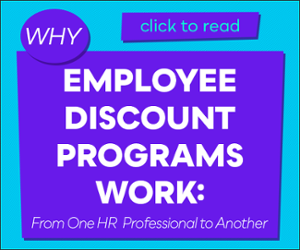You’ve got big goals at your company. As a leader, a big part of your job is inspiring your workers to get on board with those central goals.
But here’s the thing. Your business goals will never be as important to them as their own personal goals. To make it even more complicated, those personal goals are as diverse and unique as the people behind them.
You reward your workers when they help accomplish company objectives, give bonuses for meeting aggressive targets, and recognize those who go above and beyond. Isn’t it fair to assume people would be more motivated to support a company that goes above and beyond to help them reach their own personal goals. Studies show workers are responding positively to employers that do. Moreover, Americans report they believe employers have a literal responsibility to help them become “net better off” in all areas of their lives.
And that’s exactly the reason why lifestyle benefits for employees are growing so fast in popularity. They’re becoming nearly as ubiquitous as more common benefits like health insurance and paid time off.
In this article, we’ll dive into why lifestyle benefits are so compelling. Plus, we’ll give some tips on how to know which will be most effective for your unique workforce.
What are Lifestyle Benefits?
Why Offer Lifestyle Benefits?
Lifestyle Benefits Work – Here’s Why
Top 101 Lifestyle Benefits for Employees
How to Choose the Right Lifestyle Benefits for Your Workforce
What are lifestyle benefits?
Lifestyle benefits are specialized employee perks offered above and beyond salary compensation – specifically those that support workers' lives and goals outside the workplace.
If that’s a little bit heavy, let’s take a second and break it down a bit.
There are lots of different ways a company compensates its team for the work they do. Each has a slightly different goal in mind.
Salaries and wages are, of course, the main method of compensation. Without this, you don’t have employees, you just have volunteers (and probably not for long, because people need money to, like, eat and stuff).
There are only a few federally mandated benefits companies are legally required to offer, like Social Security and Medicaid, unemployment insurance, workers’ compensation insurance, and FMLA.
Though not legally mandated, most companies offer a core benefits package of paid time off, medical insurance, and retirement options. Businesses offer benefits like these to stay competitive enough to attract and retain people. Paid time off could include holidays, flexible vacation days, and sick leave. Medical insurance may include dental and/or vision insurance. Popular retirement options include 401K (with or without company match) or pension plans, etc.
Here's where we come to employee perks (a.k.a. fringe benefits, ancillary benefits, and/or voluntary benefits), which is a catch-all category for the many non-salary benefits an employer might choose to offer. They can be broken down into various subcategories, but the boundaries are pretty murky. Most perks could easily fit into multiple subcategories.
So here’s the golden question: what elevates an employee perk to be a lifestyle benefit?
The thing that sets lifestyle benefits apart – what makes them so meaningful and impactful – is they help workers reach their own most important life goals. Think about the things that matter most to you. The list might include your physical health and mental health, personal financial health, the safety and happiness of your family, personal growth and education. The list could go on and on. Therefore, any perk that would support you in one of these goals would qualify as a lifestyle perk. Need an example? We’ve got lots below!
Why Offer Lifestyle Benefits?
Why would a company fork out the money for a benefit that only helps workers outside of the workplace?
 First and foremost, it’s a way to support the people who support you. After all, employees dedicate a large chunk (an average of 50%) of their waking hours to work, and 87% of them feel more job satisfaction when they have empathetic leaders. Workers can sense when their employer cares about their well-being, leading 80% of employers to conclude that one of the important reasons to offer benefits is to “meet the needs of employees across all life stages and the diversity spectrum.”
First and foremost, it’s a way to support the people who support you. After all, employees dedicate a large chunk (an average of 50%) of their waking hours to work, and 87% of them feel more job satisfaction when they have empathetic leaders. Workers can sense when their employer cares about their well-being, leading 80% of employers to conclude that one of the important reasons to offer benefits is to “meet the needs of employees across all life stages and the diversity spectrum.”
Think of it this way. Remember how we said employees have goals that are important to them? Company objectives rarely even make the list and will never hold the same place in your workers’ hearts as their own personal goals. To complicate things further, people who are experiencing trouble at home, or stress surrounding these goals, can have even more trouble focusing on work when they are at work.
How do benefits fit into this equation? People who use their voluntary benefits and have a good experience are 1.3x as likely to feel cared for, 1.3x more likely to feel engaged, and 1.2x as likely to feel productive at work.
Clearly some distinct and measurable benefits come from providing desirable lifestyle benefits to your team.
For one thing, helping make sure all their other needs are taken care of can clear up space in their limited attention for what matters most to you. Stress is a major killer of productivity. The right lifestyle benefits are highly effective destroyers of homelife stress.
In addition, workers will give their loyalty to an employer who helps them succeed where it matters. After all, 60% of job seekers strongly consider a company’s perks and benefits before accepting a job offer. When it comes to recruiting top talent, if a candidate’s offers are comparable (as they often are), an attractive lifestyle benefits package can set you apart. And, if your current workforce already has fulfilling benefits at your company, it’s a lot harder for other companies to woo them away, even with higher salaries.
Need another reason to offer lifestyle benefits? They’re relatively inexpensive compared to a pay raise, and yet, they can have an even greater emotional impact. In other words, they make a big difference to workers but have a small impact on the budget.
Lifestyle Benefits Work – Here’s Why
You might ask: How can I help my team members feel more valued, secure and enriched? How can I attract the best talent? How can I increase employee engagement and retention? To all these questions and more, lifestyle benefits are a solid answer.
People are placing more and more value on the benefits they receive from a job AND are becoming more vocal about it. In fact, 1 in 3 employees would choose more benefits over a pay raise. One survey showed a direct correlation between benefits and job satisfaction as 82% of employees with 10+ benefits reported they were “thriving” at work, whereas only 58% with 1-4 benefits could say the same.
Plus, many companies are reporting lifestyle benefits directly increase engagement and productivity. This happened even after the pandemic (and the resulting shift toward remote work that followed) revealed competitive pay alone wasn’t enough to keep people fully engaged.
Here are some of the reasons lifestyle benefits work so well:
1. Lifestyle Benefits are data-driven and thus can be personalized to your workforce.
Lifestyle benefits are only as effective as a business’s ability to choose ones that will be used and loved. As they become more ubiquitous among businesses big and small, ideas and data are being shared. This is great for any business wanting to get started. Data shows certain benefits are popular among various demographic groups based on age, gender, interests and more.
But when it comes to designing your own lifestyle benefits, the prime source of information (and really the only source you need) is the actual people working for you right now. The great news is people are more than willing to share what benefits they want. All you need to do is ask.
This makes lifestyle benefits infinitely customizable, not just business by business, but worker by worker. Yet, the real magic comes from each person’s ability to choose. For example, even among health and wellness benefits, people have varied definitions of health and want to support their own in the manner most meaningful to them. Because lifestyle benefits are typically more affordable for companies to offer, they can give an array of options and allow workers to choose the ones most relevant to them.
Better still, when you go through the whole process (we break the process down below), workers feel seen and appreciated. It demonstrates to them you are interested in their total well-being and you care about more than just how they benefit you.
2. Lifestyle benefits are easily adjusted to changing economic stressors.

Money will indeed fix many of life’s current woes: inflation, student loan debt, increasing rent, etc. The simplest answer may seem to be giving workers more money in the form of pay raises. However, compensation increases can be a long-term solution applied to a temporary problem. It’s not sustainable for most employer budgets. Even more importantly, (and this may surprise you) it doesn’t have the same emotional impact as directly acknowledging and addressing the issues your workforce is currently facing.
Many lifestyle benefits are driven by socio-economic factors like the rising cost of healthcare, the caregiver crisis and the recession. Therefore, companies can change their lifestyle benefits offerings to find new answers when different troubles arrive. Just as importantly, each worker can adjust their benefits as they move between life’s challenges.
3. Lifestyle benefits are inclusive.
Not all benefits are created equal, and neither are the people who may or may not use them. For instance, health insurance is too expensive to offer to part-time employees and freelancers. Some workers do not have enough room in their budgets to take advantage of a 401K match program. Perks like parental leave, tuition reimbursement and childcare assistance are only useful to the workers in those particular seasons of life, which is why utilization averages between <1% to maybe 15% among workforces.
It may feel as though your core benefits are universal, and therefore of equal importance to all. Admittedly, few benefits are truly universal on their own (though discount programs with a focus on everyday essentials come about as close as you can get). Yet, a suite of inclusive benefits handpicked to fit your unique workforce can allow each worker to design a benefits package that perfectly matches his/her needs. That way no one feels like they’re missing out on anything.
4. Lifestyle benefits are meant to be used right away, in a positive way.
If you think about it, most traditional benefits are not actually intended to be used… at least not often. For example, various insurances can help you have peace of mind but are only useful if you become sick, disabled, or even deceased (in the case of life insurance).
Lifestyle benefits, on the other hand, are meant to be enjoyed right away, the more the better. That’s because each time a perk is used, it’s a chance for an employer to positively interact with its workforce, even outside of work hours in a way that furthers – instead of damages – work-life balance. Happy workers are at least 12% more productive than their unhappy counterparts. The funny thing about workplace happiness is it translates into happier home life for 70% of workers. Happiness at home and at work are intrinsically linked so it makes sense that supporting workers’ personal goals will bring benefits back into the office.
Top 101 Lifestyle Benefits for Employees
Many companies have already begun to integrate lifestyle benefits into their benefits packages. Granted, not every company has the budget to offer a $1200 wellness stipend (to use on massages and other physical therapy) as Salesforce does or run 30 on-site cafes with varied worldwide cuisines like Google. However, there’s a wide variety of lifestyle benefits to fit any employer’s budget and/or need (even with new worker needs emerging every day).
Below is a list of lifestyle benefit ideas in the most popular wellness categories:
Health & Wellness
More than half of Americans have a goal to improve their physical and mental health. Many lack the knowledge, resources, time, or motivation to succeed; therefore, lifestyle benefits that fill these gaps are extremely popular.
 Health has a huge impact on productivity and expenses in the workplace. Poor choices regarding nutrition, physical activity, smoking, etc., incur $530 billion per year in additional healthcare costs and lost productivity due to absenteeism (missing work) and presenteeism (working at reduced capacity at work). The World Health Organization reported a 25% increase in reported anxiety and depression post-pandemic AND at the same time, people are having a harder time finding access to professional mental health resources.
Health has a huge impact on productivity and expenses in the workplace. Poor choices regarding nutrition, physical activity, smoking, etc., incur $530 billion per year in additional healthcare costs and lost productivity due to absenteeism (missing work) and presenteeism (working at reduced capacity at work). The World Health Organization reported a 25% increase in reported anxiety and depression post-pandemic AND at the same time, people are having a harder time finding access to professional mental health resources.
We can conclude that aiding your workforce in meeting their health and wellness goals is in your own best interest.
Physical Fitness. Nutrition and physical activity are the pillars of physical wellness. Yet there are also other ways to support worker health. Some lifestyle benefits growing in popularity include corporate wellness programs, gym memberships, onsite workout equipment, morning yoga, healthy breakroom snacks, rewards for meeting health goals, nutritionist and exercise coaches, wearable fitness trackers, team sports sponsorships, massage stipends, food stipends, health competitions with prizes, preventive health screenings, health fairs, flu shot clinics, and ergonomic chairs, keyboards, etc.
Mental Wellness. Mental wellness concerns bombard people from every direction. You can support your workers’ mental wellness by offering benefits that ease the stresses that come from inside AND outside the office. For businesses, these benefits might include mental health counseling, mental health days off, support groups, game and meditation rooms, flexible schedules, sleeping pods, outdoor time, casual dress code, subscriptions to apps for meditation, music, sleep, etc., and crisis support.
Financial Health
Cost of living is rising faster than salaries, meaning your team’s purchasing power is actually decreasing. Debt is at an all-time high; savings are at an all-time low. Is it any wonder that U.S. workers reported the number one thing keeping them up late at night is worrying about paying their monthly expenses? Worse for employers, they’re bringing those worries to work and spending as much as 8 working hours per week stressing about finances.
Even during the best of times, many people experience stress surrounding their finances, and pay raises aren’t always the answer. In a Glassdoor survey, 80% of employees preferred getting additional benefits over getting a pay raise.
Discount Programs. Employee discount programs are a popular option for helping people stretch their paychecks further without costing the employer a lot of money. The best employee discount programs will save them money on the things they purchase every day, like food, clothing, school supplies, home goods, gifts, technology, phone & internet service, entertainment, oil changes, car maintenance & repairs, travel expenses and home improvement.
Future Planning. Workers with a good financial footing will appreciate any guidance you can give them in crafting a secure financial future. Growing in popularity are services like access to a financial advisor, LSAs (lifestyle spending accounts), HSAs (health savings accounts), emergency savings accounts, profit sharing, stock options, investment clubs and learning opportunities, and 529 college savings match.
Debt Relief. By mid-2024, household debt in America reached the highest level ever recorded. It’s a significant source of stress to most people, and many are eager for perks that can help relieve the burden, like student loan repayment assistance, refinancing assistance, paycheck advances (to avoid predatory lenders), incentives for improving financial behavior, tax assistance programs, debt counseling services, budgeting apps and flexible perk stipends.
Corporate Pricing on Essentials. Group rates can bring down the price of many of the optional but desirable services that might be out of reach for individuals. People can choose what to pay for (fully or partially) themselves but at a lower price. Group rates commonly include life insurance, vision insurance, accident insurance, disability insurance, legal service, identity theft protection and cell phone plans.
Housing assistance. Between steeply rising costs for houses, high mortgage rates and a general housing shortage, home ownership has never felt so out of reach for many Americans. Renters don’t have it much better with many people ending up rent-burdened as housing costs eat up 30%, 50%, or more of their take-home pay. Assisting workers with housing helps them feel more stability and loyalty to their employer. Some ideas might include down payment assistance, relocation assistance, housing stipends, mortgage rate discounts, first-time homebuyer programs, employee-sponsored housing and rent assistance/subsidies.
Transportation Benefits. There are lots of different ways to assist your workforce with everyday transportation expenses – both with the commute to work and personal travel. Some popular travel perks can include public transportation passes, use of a company car, gas stipends, bicycle care, parking reimbursement, electric vehicle charging stations and carpooling.
Personal & Family Security
Most people choose their jobs based on how well it will help them support their home life, not the other way around.
Concerns from home will continue to compete with work concerns for most workers. Among working parents, 57% have suffered burnout at some point from the pressures of balancing work and family responsibilities. The careers of women have been disproportionately affected by family concerns. This was never clearer than during the extreme conditions of the worldwide pandemic, but it’s always true. Women are more likely to get called away when a child is sick or childcare falls through. They’re also more likely to put their careers on hold to become unpaid caretakers of aging family members.
No matter what their home life looks like, work-life balance continues to grow in importance to workers, so much so that many would prioritize it over even a pay raise. Therefore, benefits that help them feel secure that home life is running smoothly in their absence will help them keep their minds on the job while on the clock.
Flexibility. Many Americans crave more flexibility to support their work-life balance (especially since the pandemic when flexible schedules became the norm for many non-essential positions.) For parents and caregivers, on the other hand, flexibility could mean the difference between being able to work at all or needing to leave the workforce entirely to prioritize family needs. Flexible options could include remote work, hybrid work, home office stipends, flexible hours to plan around family routines, flexibility to respond to emergencies, compressed workweeks, and unlimited PTO.
Family Building Benefits. Family-building benefits are growing in popularity among workers. Fertility treatments, adoption and surrogacy are notoriously expensive and are often not covered by standard health care plans. Today, many people are waiting until later in life (when fertility issues can arise) to start having children, and LGBTQ+ individuals want coverage of their unique family planning needs. Family-building benefits could include subsidies for fertility treatments like IVF and IUI, egg freezing, adoption assistance, surrogacy support, paid parental leave, paid leave for adoption or foster care, mental health support for miscarriage or post-partum depression.
Child Care and Safety. Working parents who receive supportive benefits at work are much more likely to stay with an employer longer and be more productive while on the clock. Benefits like these can help alleviate concerns about children when apart or help offload essential tasks so they can have more quality time together include: childcare stipends, in-office childcare, subsidized after school programs, cleaning services, grocery delivery, family/marriage counseling and neurodiversity support.
Elder Care Support. Without some support, many younger workers are being forced to choose between careers and providing full-time, unpaid caregiving roles. With a little support, many can balance both. That’s why more employers are offering employee assistance programs (EAPs) with services like free assessments, short-term counseling, respite care (or backup child/elder care) and peer support.
Pet Care. Some people consider their animals as close as family, and they appreciate any help keeping their “furry friends” happy and healthy. For example, 69% of owners (many of whom adopted companions while working remotely during the pandemic) wish they could keep working from home so they don’t have to leave their pets alone. Many employers are choosing to ease this stress by offering pet insurance, paid days for new pet adoption, pet-friendly workplaces, discounts on pet supplies, grooming, etc., training classes, pet bereavement leave and webcam treat dispensers.
Disaster Protection. As the saying goes, “hope for the best but plan for the worst.” When you help your team do just that, you can ease those worries that might otherwise distract them from important workplace tasks. Options include identity theft insurance, legal counseling, legal services and cancer insurance.
Personal & Family Enrichment
For many people, a healthy work-life balance is about more than just making sure home-life needs are met. It’s about leading a rich life full of experiences. In fact, connectivity is one of the pillars of total wellness – connectivity with others and with the world around us. Never underestimate the power of simply helping your team enjoy life outside of work.
Experiential rewards – and the positive memories that result from them – have a larger and longer-lasting emotional impact on recipients than monetary rewards do.
 Travel Benefits. Workers who regularly use their vacation days are statistically more likely to earn raises and report they are invested in their employer’s success. So, send your workers on vacation with perks like travel stipends, personal travel allowances, discounts on hotels, flights, car rentals and other travel expenses, flexible time off, unlimited vacation days, destination discounts, corporate retreats, travel insurance and paid vacations.
Travel Benefits. Workers who regularly use their vacation days are statistically more likely to earn raises and report they are invested in their employer’s success. So, send your workers on vacation with perks like travel stipends, personal travel allowances, discounts on hotels, flights, car rentals and other travel expenses, flexible time off, unlimited vacation days, destination discounts, corporate retreats, travel insurance and paid vacations.
Entertainment. Many workers appreciate the opportunity to enjoy extravagances that might otherwise be outside the budget. Plus, getting out and enjoying life helps improve mental health and helps people return to work rejuvenated and refocused. Try offering national parks passes, discounted or free theme park tickets, discounts to theater, museums and other cultural venues, season passes to ski slopes, golf courses, etc. to share among workforce, family-friendly office events, team building activities and streaming subscription services.
Charitable Support. More people, especially the younger generations who are quickly saturating the workforce, want an employer that shares their values. In fact, 56% refuse to work for a company that doesn’t. That’s why benefits like these are becoming more and more popular: paid volunteering days off, charitable contribution matching, food and clothing drives, community clean-ups, inclusive company culture and company-sponsored blood drives.
Personal Growth & Education. For those whose lives are enriched by continuous learning, employer support is highly valued. Some ideas: tuition assistance or reimbursement, paid industry certification, memberships in professional and hobby organizations, on-site learning library, online courses, foreign language classes, mentorship programs, business and employee resource groups (BERGs) and motivational speaker series.
Choosing the Right Lifestyle Benefits for Your Workforce
If you haven’t dipped your toes into the wide world of lifestyle benefits, now is a great time to start. You’ll have to invest some time and effort in both setting up AND maintaining an effective lifestyle benefits strategy. We’ve studied successful businesses and found the strategies they share.
For example, to succeed, you may have to change the way you think about employee benefits. The whole concept of worker compensation is evolving. Businesses used to have a compensation strategy and a separate employee perks strategy. More and more, they’re seeing the benefits of integrating the two under a coordinated strategy. This includes featuring lifestyle benefits with higher emphasis when discussing salary.
Don’t know exactly how to get started? Many companies have found great success by following the steps below. Steps 1 and 2 will help you pinpoint the best lifestyle benefits for your workforce, step 3 will help you get your new program up and running and step 4 will help encourage good participation.
Step #1: Outline your demographics
Professional studies about employee benefits reveal that similar demographic groups gravitate to certain benefits. Therefore, a small amount of research at the very beginning can save you work later. It’ll help you hone in on relevant benefits (that you can then ask your employee base about in step 2).
In examining your employees, some of the info you may want to sort for include race, gender, age, ability, years at company, salary, sexual orientation, geographic home, interests, behaviors, family life, job risk profile, etc. More diversity among your employees could require more diversity of lifestyle benefits. You want every one of them to feel seen and appreciated. (Quick note: A diverse workplace is a great asset to your company as each person can bring a unique perspective and set of talents.)
Once you know your company’s unique demographics, combine that with shared knowledge about industry trends. Having something of value for everyone helps you have an inclusive work environment where no one feels discrimination.
What can demographics tell you?
Knowing the percentage of employees you have in each age group can help you estimate how many will prefer certain benefits that typically correspond with stages of life: tuition reimbursement, parental leave, retirement, etc.
Knowing how many employees are women, BIPOC and LGBTQ+ can help you anticipate your need for flexible scheduling, as these demographics are the most likely to hold the mantle of caregiver of children and aging parents.
Demographic information will start you down the right path, and your employees can take you the rest of the way.
Step #2: Survey for wants and unmet needs
The only way to know for sure what benefits your employees prefer is to ask. The good news is, employees who choose, use and are satisfied with their personalized benefits are more likely to feel holistically healthy and happy at work.
The easiest way to ask is through employee surveys. Businesses are finding employees appreciate being asked—and they’re happy to give you all the information you need.
Some of the information you’ll want to discover may include:
- Stressors affecting their lives
- Their most important goals: health, finance, family, etc.
- Needs that aren’t being met
- Current benefits they value most
- The benefits they most desire
If you’re not sure where to start, there are plenty of sample survey questions already suggested by companies who have done this before. These can give you a good starting place.
With all that’s going on in their lives, (consider how many world-altering events have happened in the last few years) ensuring that workers feel cared for is more important than ever.
Step #3: Design a Suite of Lifestyle Benefit Options based on needs, budgets, resources, etc.
Once you’ve gathered all the information you need in the first two steps, it’s time to get into the nuts and bolts of building your lifestyle benefits strategy.
- Choose the benefits that will help the largest variety of people.
- Ensure you offer at least one lifestyle benefit that will help every worker in your company.
- Decide how many new lifestyle benefits to offer. (The good news is all your preparations will mean you’ve probably identified a few meaningful benefits that will make a big impact.)
- Decide if you will launch a new suite of benefits all at once, or slowly introduce one benefit at a time.
- Periodically revisit steps 1 and 2 when turnover changes your workforce identity enough to warrant a change in benefits.
As you design your suite of benefits, here are a few other considerations to keep in mind:
Cost vs. Value: Since some benefits cost more than others, you’ll want to keep a close eye on the bottom line as it relates to your benefits budget.
Examine whether a benefit is employee-paid, employer-paid or employer-supplemented. It’s good to have a mix of all three. Employee-paid benefits are optional, but stats are showing that people are willing to opt in and pay for benefits they feel will be of great value to their lives. Employer-supplemented means the employee and employer share the cost. Employee-paid come with the highest cost, but also have the potential to deliver the biggest emotional punch.
 A fourth option is to partner with a benefits provider. The good news is some will even help fund the rewards they promise. Just use caution when a benefits provider partner offers a benefit for free. This happens sometimes among discount program providers—and it often indicates the value is low and forgettable. Worse still, they may even be getting their money through other means – like by selling your workers’ information to spammers. This may not cost you any money, but it will cost you a lot more: the very employee loyalty and engagement that you are after in the first place.
A fourth option is to partner with a benefits provider. The good news is some will even help fund the rewards they promise. Just use caution when a benefits provider partner offers a benefit for free. This happens sometimes among discount program providers—and it often indicates the value is low and forgettable. Worse still, they may even be getting their money through other means – like by selling your workers’ information to spammers. This may not cost you any money, but it will cost you a lot more: the very employee loyalty and engagement that you are after in the first place.
Taxable Income vs. Gifts: You’ll want to know (and be able to help your workers navigate) which benefits are considered taxable income and which are not.
Free-For-All vs. Merit-Based: Some benefits are traditionally offered to everyone, while others (like a company car) are more often reserved for those who reach a certain level of management, or meet aggressive sales goals. It’s okay to have some of each, but to be truly inclusive, most should be freely available to every worker no matter what.
Too-Much-Choice Dilemma: Not only is it too expensive for organizations to offer unlimited options, it could just as easily be overwhelming for workers to choose from too many options. When you tailor your offerings to what workers ask for, you demonstrate that you are listening and valuing their opinions.
Delivery is Everything: There are lots of different platforms through which you can offer benefits: websites, apps, dedicated platforms or one central delivery system. But no matter which you decide on, delivery must be simple and clear. People will only return if they have a positive experience with the platforms they interact with.
Step #4: Promote, promote, promote!

Lifestyle benefits aren’t something you can mention only once and expect to have high usage. Frequent communication is vital to ensuring the benefits are always top-of-mind.
Therefore, you need to continually remind people about their benefits. The good news is you can probably utilize many of the methods of communication you’ve already established:
- Employee newsletters
- New hire packets
- Dedicated emails
- Benefit guides
- Breakroom flyers
- Onsite health fairs
Reminding your workers about their lifestyle benefits gives you a positive and meaningful reason to reach out regularly.
Employee Discount Programs: A Popular Lifestyle Benefit
When you follow these steps to listen and respond, workers will know you care about their entire lives, not just for what they can do for you.
Access Perks operates the world’s largest and most comprehensive employee discount program. So, we know that discount programs can be one of the most versatile and universally loved benefits—as long as it is done right. The best discount programs help every worker stretch their hard-earned paychecks by offering big value on a wide range of everyday necessities.
At Access Perks, we specialize in in-store, local discounts on food, clothing, auto care, services, travel and other everyday expenses. Plus, we offer a dedicated travel discount platform that gives members up to 50% off hotels, theme park tickets, car rentals and more. If you’d like more information, contact us. In the meantime, here are some more articles on the power of well-balanced employee discount programs.
- Why Employee Discount Programs Work: From One HR Professional to Another
- The Ultimate Employee Discount Program Buyer’s Guide [New FREE Ebook]
- The Discounts Employees Want (Based on What They Buy)
- Employee Discount Programs Revealed: 10 Questions to Ask Before You Buy











